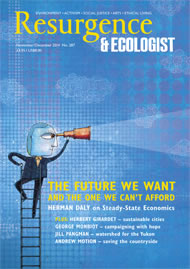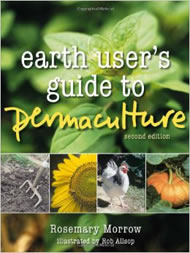Back in the late 1970s two Australians, Bill Mollison and David Holmgren, had an idea that was born out of a deep relationship with Nature. They looked at natural ecosystems – completely self-sustaining, producing abundant biomass each year and causing no pollution – and wondered whether we could learn from them. Could we feed ourselves by similar means rather than by agriculture, with all its heavy inputs and undesirable outputs such as soil erosion? This inspiration was the beginning of permaculture.
Since then the idea has developed into a wide-ranging methodology. It has spread all over the world, and everywhere it has spread it has adapted to local circumstances and local culture. Britain has been one of the places where it has struck the deepest roots, and it is interesting that the principal publisher of permaculture books worldwide is in Britain and is publishing the Earth User’s Guide to Teaching Permaculture by Rosemary Morrow, an Australian teacher. Permanent Publications was involved in the publication of a previous teaching manual, the Permaculture Teachers’ Guide, and it is useful to compare the two books.
It’s not just that the earlier book was a collaboration by a whole group of British teachers, whereas Morrow’s is a much more unified work by a single teacher. The comparison also reveals how much permaculture has changed through being transplanted to the other side of the world. Here in Britain, where most of us live in cities and land prices make the dream of a patch of land in the country beyond the reach of most of us, permaculture has a more urban tinge, and the main focus is on the domestic garden. In Morrow’s book, the domestic garden is just one topic out of a total of forty. Most of her book is about larger-scale growing. In particular, she includes a great deal more about domestic animals in permaculture than any European teacher that I’m aware of does.
By chance, I recently saw the course material of another Australian teacher, Geoff Lawton. I was struck by how closely he follows the classic system of permaculture laid out in Mollison’s 1988 book, Permaculture: A Designers’ Manual. Morrow’s book falls somewhere between Lawton and the British norm – somewhat changed from Mollison’s original, but not by very much.
For me as a British teacher of permaculture, reading Morrow’s book was a useful exercise. It made me reflect on just how far we have taken permaculture from its Australian original, and to question that distance. It’s not just a matter of urban–rural differences, but one of climate too. Morrow holds to the dictum that the best place to store water is in the soil, and this is absolutely true for Australia, where the soil water is more often in deficit than in surplus and, in most of the country, rain falls in the growing season rather than in winter. In Britain, however, where the reverse is true, the pattern must be different: keep the soil well drained, and store winter rainfall for summer irrigation. To give the author her due, she does mention that teachers who practise in different climatic regions will need to adapt the information in the book to local conditions.
The book is very much about what Morrow teaches rather than how she teaches it. There’s little on teaching method, and perhaps she assumes that would-be teachers of permaculture will themselves have already taken a short course in teaching adults (an excellent idea, in my opinion). So what we have is an account of Rosemary Morrow’s course contents. All permaculture teachers will benefit from reading them and pondering on how their own course material compares. Have we departed too far from the original? Personally, I think not – but it is an important question to ask ourselves.








